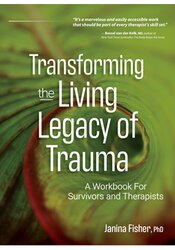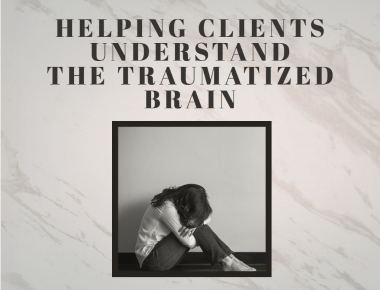Helping Clients Understand the Traumatized Brain
Learn From An Expert And Earn Free CE

The brain is the most complex organ in the body, and it affects everything we feel and do, not just what we think.
Divided into different structures, each with a different purpose, our brains rely on instantaneous coordination of multiple areas to accomplish most things. If we have lost the car keys, for example, we might try to visualize where we last saw them and then reconstruct, frame by frame, what we did after that.
This process requires coordination of two different brain areas: the part of the brain that stores visual memories and the part of the brain in charge of “working memory” (the ability to retrieve past information, compare it to present data, plan, or problem solve). Every day, we rely on the brain to get us through all of our usual routines – but without really understanding how it works.
Neuroscience research has demonstrated that trauma-related emotional and body memories are stored in the amygdala and are easily activated by triggers or by remembering traumatic events. The research also shows that verbal memory areas (which allow us to tell a story from start to finish) shut down when the amygdala is triggered and reactive.
After a traumatic event or a traumatic life, survivors might have only a very fragmented narrative of what happened or no clear story at all. Many survivors say, “I don’t remember anything,” without realizing that they are remembering when they suddenly startle, feel afraid, tighten up, pull back, feel shame or self-hatred, or start to tremble.
Because trauma is remembered emotionally and somatically more than it is remembered in a narrative form that can be expressed verbally, survivors often feel confused, overwhelmed, or crazy. Without a memory in words or pictures, they do not recognize what they are feeling as memory.
Most people are unaware of all these different ways of remembering, even though they are all too familiar with the experience of suddenly getting anxious or angry for no apparent reason. When they are triggered, they do not realize that what they are experiencing is a memory. They know the warm feeling that is connected to thinking about loved ones or the pulling back or bracing that occurs when they encounter someone who feels threatening.
In this short video, I’ll walk you through a way to explain the neuroscience behind triggering events to your clients. Once equipped with greater understanding of how triggers impact brain function, you can then delve deeper into overcoming them.
To learn more about how to help your clients transform the living legacy of trauma, join internationally recognized trauma expert, Dr. Janina Fisher, in this
*This is an adapted excerpt from Transforming the Living Legacy of Trauma by Janina Fisher. Copyright ¬© 2021, Janina Fisher. ∞≈¿÷ ”∆µ Publishing & Media.
Divided into different structures, each with a different purpose, our brains rely on instantaneous coordination of multiple areas to accomplish most things. If we have lost the car keys, for example, we might try to visualize where we last saw them and then reconstruct, frame by frame, what we did after that.
This process requires coordination of two different brain areas: the part of the brain that stores visual memories and the part of the brain in charge of “working memory” (the ability to retrieve past information, compare it to present data, plan, or problem solve). Every day, we rely on the brain to get us through all of our usual routines – but without really understanding how it works.
Neuroscience research has demonstrated that trauma-related emotional and body memories are stored in the amygdala and are easily activated by triggers or by remembering traumatic events. The research also shows that verbal memory areas (which allow us to tell a story from start to finish) shut down when the amygdala is triggered and reactive.
After a traumatic event or a traumatic life, survivors might have only a very fragmented narrative of what happened or no clear story at all. Many survivors say, “I don’t remember anything,” without realizing that they are remembering when they suddenly startle, feel afraid, tighten up, pull back, feel shame or self-hatred, or start to tremble.
Because trauma is remembered emotionally and somatically more than it is remembered in a narrative form that can be expressed verbally, survivors often feel confused, overwhelmed, or crazy. Without a memory in words or pictures, they do not recognize what they are feeling as memory.
Most people are unaware of all these different ways of remembering, even though they are all too familiar with the experience of suddenly getting anxious or angry for no apparent reason. When they are triggered, they do not realize that what they are experiencing is a memory. They know the warm feeling that is connected to thinking about loved ones or the pulling back or bracing that occurs when they encounter someone who feels threatening.
In this short video, I’ll walk you through a way to explain the neuroscience behind triggering events to your clients. Once equipped with greater understanding of how triggers impact brain function, you can then delve deeper into overcoming them.
To learn more about how to help your clients transform the living legacy of trauma, join internationally recognized trauma expert, Dr. Janina Fisher, in this
*This is an adapted excerpt from Transforming the Living Legacy of Trauma by Janina Fisher. Copyright ¬© 2021, Janina Fisher. ∞≈¿÷ ”∆µ Publishing & Media.
Transform traumatic experiences with this...

Dr. Janina Fisher, international expert on trauma, has spent over 40 years working with survivors, helping them to navigate the healing journey.
In Transforming the Living Legacy of Trauma, Janina shows how the legacy of symptoms helped them survive and offers:
Transforming the Living Legacy of Trauma is a workbook and guide to the journey to healing. As a ‘guidebook,’ it describes the terrain to be explored, and it provides maps to help travelers find the best routes to a life beyond trauma.
In Transforming the Living Legacy of Trauma, Janina shows how the legacy of symptoms helped them survive and offers:
- Step-by-step strategies that can be used on their own or in collaboration with a therapist
- Simple diagrams that make sense of the confusing feelings and physical reactions survivors experience
- Worksheets to practice the skills that bring relief and ultimately healing
Transforming the Living Legacy of Trauma is a workbook and guide to the journey to healing. As a ‘guidebook,’ it describes the terrain to be explored, and it provides maps to help travelers find the best routes to a life beyond trauma.
Meet the Expert:
Janina Fisher, Ph.D., is a licensed clinical psychologist and former instructor at The Trauma Center, a research and treatment center founded by Bessel van der Kolk. Known as an expert on the treatment of trauma, Dr. Fisher has also been treating individuals, couples and families since 1980.
She is past president of the New England Society for the Treatment of Trauma and Dissociation, an EMDR International Association Credit Provider, Assistant Educational Director of the Sensorimotor Psychotherapy Institute, and a former Instructor, Harvard Medical School. Dr. Fisher lectures and teaches nationally and internationally on topics related to the integration of the neurobiological research and newer trauma treatment paradigms into traditional therapeutic modalities.
She is co-author with Pat Ogden of Sensorimotor Psychotherapy: Interventions for Attachment and Trauma (2015) and author of Healing the Fragmented Selves of Trauma Survivors: Overcoming Internal Self-Alienation (2017) and the forthcoming book, Working with the Neurobiological Legacy of Trauma (in press).
Learn more about their educational products, including upcoming live seminars, by clicking here.
She is past president of the New England Society for the Treatment of Trauma and Dissociation, an EMDR International Association Credit Provider, Assistant Educational Director of the Sensorimotor Psychotherapy Institute, and a former Instructor, Harvard Medical School. Dr. Fisher lectures and teaches nationally and internationally on topics related to the integration of the neurobiological research and newer trauma treatment paradigms into traditional therapeutic modalities.
She is co-author with Pat Ogden of Sensorimotor Psychotherapy: Interventions for Attachment and Trauma (2015) and author of Healing the Fragmented Selves of Trauma Survivors: Overcoming Internal Self-Alienation (2017) and the forthcoming book, Working with the Neurobiological Legacy of Trauma (in press).
Learn more about their educational products, including upcoming live seminars, by clicking here.
Topic: Trauma
Tags: Anxiety | Body | Brain | Free Resources | Posttraumatic Stress Disorder (PTSD) | Therapy Tools | Trauma



